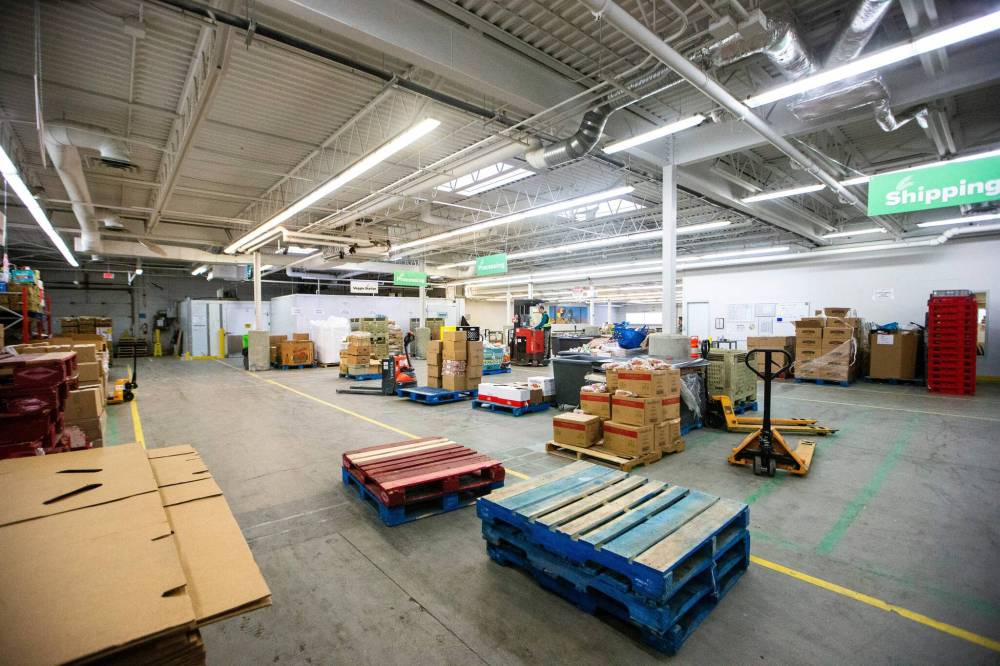Level of need reflected in local food bank numbers: advocates
Advertisement
Read this article for free:
or
Already have an account? Log in here »
To continue reading, please subscribe:
Monthly Digital Subscription
$0 for the first 4 weeks*
- Enjoy unlimited reading on winnipegfreepress.com
- Read the E-Edition, our digital replica newspaper
- Access News Break, our award-winning app
- Play interactive puzzles
*No charge for 4 weeks then price increases to the regular rate of $19.00 plus GST every four weeks. Offer available to new and qualified returning subscribers only. Cancel any time.
Monthly Digital Subscription
$4.75/week*
- Enjoy unlimited reading on winnipegfreepress.com
- Read the E-Edition, our digital replica newspaper
- Access News Break, our award-winning app
- Play interactive puzzles
*Billed as $19 plus GST every four weeks. Cancel any time.
To continue reading, please subscribe:
Add Free Press access to your Brandon Sun subscription for only an additional
$1 for the first 4 weeks*
*Your next subscription payment will increase by $1.00 and you will be charged $16.99 plus GST for four weeks. After four weeks, your payment will increase to $23.99 plus GST every four weeks.
Read unlimited articles for free today:
or
Already have an account? Log in here »
Hey there, time traveller!
This article was published 19/02/2024 (641 days ago), so information in it may no longer be current.
When Agape Table general manager Dave Feniuk heard Harvest Manitoba food bank had served 21,575 households in January, he was a little surprised.
Based on the level of need he saw in Winnipeg all month long, “It actually sounds kind of low.”
Agape Table served around 1,200 people out of the Wave Church on Furby Street in January through bagged meals twice a week and a weekly food bank. Feniuk said staff found it to be a difficult month for both donors and the people they serve.

“December is usually a time where individuals and companies want to give back. It’s the festive season and they come out and do team building and things like that. January, it’s typically quite a bit colder, as people… find they may have overspent, if they actually had the money to spend,” he said.
“Typically, they call it Blue Monday — the second Monday of January,” Feniuk said. “And that’s when you find a lot of people coming down after the Christmas season and getting more depressed.”
January’s count of households served by Harvest is over 3,000 more than January 2023. The average monthly number of households using Harvest’s food banks from April 2023 to January was 19,997; from April 2022 to March 2023, it was 15,713.
While recent announcements from the province — including $30 million toward its goal to create a “universal” school meal program in Manitoba — sound promising to Harvest director of network, advocacy and education Meaghan Erbus, they aren’t close to meeting the level of need.
“I am optimistic when you see investments in that way made, that poverty and food insecurity is top of mind for the provincial government… I’m optimistic that when we put it out there, that the government will hear us,” she said.
“But I am not optimistic that even in these changes, that it’s going to make real change in the number of folks that are accessing our food banks. There’s much more that needs to be done.”
Harvest Manitoba’s data comes the same week Manitoba was ranked the province with the second-highest level of child poverty — 24 per cent of Manitobans 17 and younger live in poverty, just 0.2 percentage points fewer peers in Saskatchewan.
Manitoba still has the highest number of children under six living in poverty of all the provinces (Nunavut is the only region with a higher count).
It is a hugely concerning statistic, considering the severe impact poor nutrition can have on infants and children, said Kate Kehler with the Social Planning Council of Winnipeg.
“The health effects of not having adequate nutrition leads to things like higher dental extractions, and we know it also affects childhood development and brain development when they don’t have adequate food,” she said.
“And the research shows over and over again, that even short stints in poverty can have a long impact on actual brain development, and under the age of six, that is the most crucial period.”–Kate Kehler
“And the research shows over and over again, that even short stints in poverty can have a long impact on actual brain development, and under the age of six, that is the most crucial period.”
Nationally, the child poverty rate for children under six is 16.1 per cent; in Manitoba, it is 27.2 per cent.
Kehler — and the Social Planning Council’s report on child poverty — asked where the political will is on treating the skyrocketing numbers of Manitobans in need like the emergency it is.
“Our previous provincial election (Oct. 3, 2023) focused very much on affordability, they didn’t talk poverty very much at all. In fact, it was very difficult to get the subject raised,” she said.
“And that is simply because affordability is something that speaks more to the middle class and we know the middle class votes, people in poverty don’t.”
It is up to people who are living more comfortably to call on the NDP government to use their previous promises of affordability to impact those most in need first, Kehler said — pointing to the six-month gas tax holiday as an example.
Data has suggested the distribution of gas tax cut benefits could benefit the highest-income quintiles exponentially more than the lowest, and Kehler said the $163 million the cut is expected to cost should be going to those most in need.
“We have to stop letting politicians tell us, ‘Let us cut you a cheque, and that will be good,’” she said. “It doesn’t allow us to fund the systems that we need to be fully funded.”
malak.abas@freepress.mb.ca

Malak Abas is a city reporter at the Free Press. Born and raised in Winnipeg’s North End, she led the campus paper at the University of Manitoba before joining the Free Press in 2020. Read more about Malak.
Every piece of reporting Malak produces is reviewed by an editing team before it is posted online or published in print — part of the Free Press‘s tradition, since 1872, of producing reliable independent journalism. Read more about Free Press’s history and mandate, and learn how our newsroom operates.
Our newsroom depends on a growing audience of readers to power our journalism. If you are not a paid reader, please consider becoming a subscriber.
Our newsroom depends on its audience of readers to power our journalism. Thank you for your support.
History
Updated on Tuesday, February 20, 2024 8:20 AM CST: Adds photo










